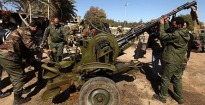How Strong Are Libya's Air Defenses?
 Wired reports:
Wired reports:
If President Obama gives the order, a high-tech fleet of U.S. Navy and Air Force fighters will sweep across Libya. Then the Gadhafi regime would likely strike back, with the second-biggest Surface-to-Air Missile network in Africa — plus the remnants of the dictator’s dilapidated fighter force. The ensuing battle would probably be brief but intense. In the end, the U.S. would be able to install a “no-fly zone” over the country, protecting Libyan rebels from strikes from above. But “it would be challenging,” Gen. James Mattis, U.S. Central Command boss, warns of a possible air campaign over Libya.
“You would have to remove the air-defense capability, in order to establish the no-fly zone,” Mattis adds. “So it — no illusions here, it would be a military operation. It wouldn’t simply be telling people not to fly airplanes.”
“Libya possesses one of the most robust air-defense networks on the African continent, falling second only to Egypt in terms of coverage and operational systems,” Sean O’Connor, an air-defense analyst, wrote in a May 2010 assessment. “Libyan strategic SAM assets are primarily arrayed along the coastline, ostensibly defending the bulk of the Libyan population and preventing foreign incursion into Libyan airspace.”
With rebels holding several cities, it’s unclear how many SAMs are still operational. Last May, O’Connor counted 31 long-range SAM sites and 17 radars belonging to the Libyan air force. The bulk of this “strategic” missile force comprises Soviet-designed SA-2, SA-3 and SA-5 systems dating from the 1970s and 1980s. In addition, the Libyan army possesses a large number of short-range SA-6, SA-8, SA-9, SA-13 and Crotale missiles.
For its part, the Libyan fighter force in theory numbers around 200 planes — mostly old Soviet and French designs. Defectors flew two Libyan Mirage F.1 fighters to Malta. Another Libyan fighter crew bailed out of their Su-22 jet rather than follow orders to bomb protesters. It’s likely very few Libyan fighters remain operational. Those that do are mostly being used to attack rebels, and wouldn’t pose much of a challenge to U.S. and allied planes.
Click here to read more.

